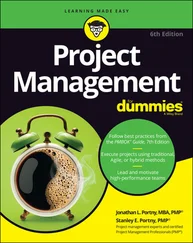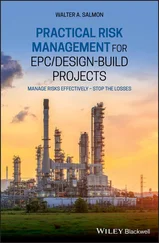Matthew Batchelor - Project Management
Здесь есть возможность читать онлайн «Matthew Batchelor - Project Management» — ознакомительный отрывок электронной книги совершенно бесплатно, а после прочтения отрывка купить полную версию. В некоторых случаях можно слушать аудио, скачать через торрент в формате fb2 и присутствует краткое содержание. Жанр: unrecognised, на английском языке. Описание произведения, (предисловие) а так же отзывы посетителей доступны на портале библиотеки ЛибКат.
- Название:Project Management
- Автор:
- Жанр:
- Год:неизвестен
- ISBN:нет данных
- Рейтинг книги:4 / 5. Голосов: 1
-
Избранное:Добавить в избранное
- Отзывы:
-
Ваша оценка:
- 80
- 1
- 2
- 3
- 4
- 5
Project Management: краткое содержание, описание и аннотация
Предлагаем к чтению аннотацию, описание, краткое содержание или предисловие (зависит от того, что написал сам автор книги «Project Management»). Если вы не нашли необходимую информацию о книге — напишите в комментариях, мы постараемся отыскать её.
Project Management — читать онлайн ознакомительный отрывок
Ниже представлен текст книги, разбитый по страницам. Система сохранения места последней прочитанной страницы, позволяет с удобством читать онлайн бесплатно книгу «Project Management», без необходимости каждый раз заново искать на чём Вы остановились. Поставьте закладку, и сможете в любой момент перейти на страницу, на которой закончили чтение.
Интервал:
Закладка:
• A project has a specified outcome.Unlike a job or work role where you are likely to have aims that change over time, a project sets out to achieve a stated goal (or goals) within a certain timetable.
• A project involves a number of different tasks.These tasks are generally defined as the smallest useful units of work. Related tasks are often combined into work packages or activities, which can be assigned to a single supplier or team.
• Each task will ideally be carried out by someone with suitable skills.Project working therefore calls for a multidisciplinary approach. The more complex a project, the greater the degree to which people and tasks need to be carefully matched.
one minute wonderAre you still confused about what a project is? Take a moment to consider this: despite their very different sizes, delivering the 2012 London Olympics and relocating your team to an office down the corridor are both projects. ‘Being a sales rep’ is not a project because it is an ongoing work role. On the other hand, a plan ‘to deliver a 20 per cent increase in sales leads through the installation of a new marketing database’ is likely to fulfil the critera for a project.
• A project is self-contained.It has its own aims, timetable and resources. That’s not to say that projects should be sealed off from the rest of the business – they can and should utilize skills and resources possessed by the wider organization, and the lessons learned should be exported to other colleagues and teams, and used on future projects.
Though they are capable of standing alone, projects may be linked to a wider programme of work, or be part of a portfolio of similar projects.
Adopting a project approach can yield significant benefits by defining clear outcomes against which to measure the input of resources and the quality of the project team and leadership. A project’s resources can be human, or financial or physical – equipment and so on.
1.2 Understand project constraints
Planning your project will involve making a series of assumptions and a consideration of the constraints facing your project. Understanding these factors will help you plan a project that is of the right size and has appropriate objectives.
The assumptions you might make about a project normally involve things such as:
• Scope (scale).How big is the project? Where does it fit into what your organization is doing? Roughly how much money is likely to be available?
• People.Who can I get to help deliver this project?
• Physical resources.What equipment and meeting space, for example, will be available?
None of this information has to be 100 per cent (or even 90 per cent) accurate at the outset. Nevertheless, understanding the assumptions around a project is an important first step – even if at this stage there are more questions than answers!
A useful way of looking at the constraints faced by projects is known as the ‘project triangle’. This model describes three main things to consider for any project:
• Time.How much of it do you have to complete your project?
• Cost.What is the available budget?
• Quality (or specification).Are you aiming to deliver something fairly basic, or more of a ‘Rolls Royce’ model?
With any project you will face a series of decisions about whereabouts in the triangle you position your project. For example, let’s say you are asked to complete an office move for your company. If you are asked to complete the move over a weekend at short notice, and given only a limited budget, you are unlikely to be able to deliver the best results. So the costs and time used will be low, but so will the quality. If you are given more time, the results will be better; if you have more time and a bigger budget, they will be better still.
Another dimension often added to this diagram is people. For any given amount of time and money, the greater the skill and motivation of the people involved, the better the results will be. Looked at this way, the triangle becomes a pyramid, with the project manager leading his or her team upward to achieve the best possible results within a given schedule and budget.
1.3 Understand the project life cycle
All projects have a recognizable ‘life cycle’. There are many different approaches to managing projects, but all agree that projects can be divided into various stages, each requiring a different focus.
The most straightforward life cycle approach recognizes four main stages of a project: aspiration, planning, implementation and measurement. You can easily memorize this life cycle because the stages both represent and substitute the words for how A Project Is Managed:
1 AspireThis stage focuses on the creation of a shared vision for your project. What are you aiming to achieve and why? How will you recognize and measure success? Whose support will you need to begin the project, and what will convince them to support you?
2 PlanThis stage looks in detail at identifying what needs to be done to deliver your project successfully. What are the various tasks that need to be done, and how can they best fit together? Who will you need on your project team? What resources will you need, both financial and physical (equipment, meeting spaces and so on)? What are the main risks to successful delivery, and how can these be avoided (or at least minimized)? Lastly, how will the project be managed, and progress communicated?
3 ImplementThis stage can be divided into two parts: motivating and monitoring. At the beginning of your project you will need to form and motivate your project team, and agree the project’s aims and working methods. Once your project is underway, your role shifts to monitoring – what progress has been made? What if any changes need to be made to the original plan? Is your project running on time, or has the schedule slipped? Are the costs as expected, or is the project in danger of going over budget? Have any problems been reported and discussed, and any necessary changes to the plan or budget been agreed?
4 MeasureOnce the project is complete, the final role of the project manager is to determine its success and to communicate the results, so that the lessons learned can be incorporated into other projects. To what extent were the original aims achieved? What went well and what went not so well? What lessons are there for future projects?
Adopting a life cycle approach will help you focus on the most important issues at each stage of the project.
1.4 Know your stakeholders
There are likely to be several different groups of people taking an interest in your project. Collectively, these people are known as ‘stakeholders’. It’s important to understand the actual stake each group has in the project – otherwise it may be difficult to balance what may seem like competing priorities. Here we outline the key roles.
• Sponsor.The person who has asked you to undertake the project, and to whom you are accountable for its success. Often, this will be a senior manager within your organization – maybe your immediate boss. On larger projects, or within larger organizations, you may be asked to report to the sponsor via a project executive.
Читать дальшеИнтервал:
Закладка:
Похожие книги на «Project Management»
Представляем Вашему вниманию похожие книги на «Project Management» списком для выбора. Мы отобрали схожую по названию и смыслу литературу в надежде предоставить читателям больше вариантов отыскать новые, интересные, ещё непрочитанные произведения.
Обсуждение, отзывы о книге «Project Management» и просто собственные мнения читателей. Оставьте ваши комментарии, напишите, что Вы думаете о произведении, его смысле или главных героях. Укажите что конкретно понравилось, а что нет, и почему Вы так считаете.












